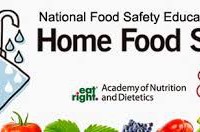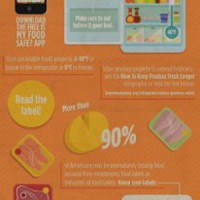It's Food Safety Education month
- Details
- Published on Monday, 08 September 2014 17:42
- Written by PRNewswire
During National Food Safety Education Month in September, keep food safe and your grocery bill in check with food storage advice from the Academy of Nutrition and Dietetics and ConAgra Foods' public awareness campaign: Home Food Safety.
"How you store food can keep it safe and fresh longer, reducing not only your risk of food poisoning, but also food waste and ultimately your grocery bill," says Marisa Moore, a registered dietitian nutritionist and spokesperson for the Academy of Nutrition and Dietetics.
Approximately 31 percent of all edible food is wasted in the U.S., and American households throw away about 19 percent of vegetables and 14 percent of the fruit they buy.
"A lot of good food goes bad before we get to enjoy it. So before you head to the store, shop in your refrigerator first," Moore says. "Cook or eat what you already have at home before buying more, but make sure to check the label or shelf life to ensure it is okay to eat."
Much food waste is due to improper storage and misreading labels, according to Moore, who offers tips to help foods last longer and reduce the amount of food wasted.
Proper Storage: "Use a refrigerator thermometer to ensure your refrigerator or freezer isn't running a fever," Moore says. Store perishable foods at or below 40°F in the refrigerator and at or below 0°F in the freezer.
Store produce properly to extend freshness. "Some fruits and vegetables should be stored in the refrigerator and others at room temperature, while some should not be stored together." Check out the accompanying Produce Storage infographic to learn more.
Reading Labels: "You can also dramatically reduce food waste in your home by knowing what the date labeling terms on the package mean to avoid throwing out food that is still OK to eat," she says. More than 90 percent of Americans may be prematurely tossing food because they misinterpret food labels according to Moore, who highlighted these key terms to look for:
- The "sell by" date tells the store the last day they should sell that specific package. "Buy the product before the 'sell by' date passes and cook or freeze the product before it expires - check the time on the Keep It Cool Storage Chart or download the Is My Food Safe? app for a list of the shelf life of common foods."
- The "best if used by" date is the recommended date for best flavor or quality.
- The "use by" date is the last date recommended for use of the product at peak quality. "Remember, you can't always tell if food has gone bad by how it looks, smells or even tastes. So if a product has a 'use by' date, definitely follow that date," Moore says.
Moore also adds that if the "use by" date is approaching, there is no need to force yourself to eat it all to avoid waste. Freeze surplus food, such as abundant seasonal produce or meats to extend its shelf life. "You can even get creative, such as freezing soon-to-expire yogurt in ice trays to later blend with fruit for a smoothie," says Moore, who highlights this technique on The Cutting Board blog.
"While it's important to reduce food waste for both the environment and our wallets, remember: When in doubt, throw it out!"
For more tips on safe food storage, read Produce from Purchase to Plate: Steps to Reduce Food Waste or see the infographic Read Food Labels to Reduce Food Waste.



















































